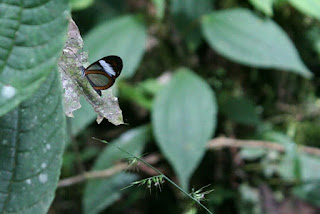 |
| Toucanet |
Our next reward was breakfast of empanadas filled with cheese and boiled eggs.
 |
| Empanadas |
The reserve includes many hectares of primary forest as well as secondary forest - that which until twenty years ago was a sugar plantation, the evidence of which has been all but eradicated by the rampant growth of vegetation. However, the lodge itself is in the tropical forest (bosque tropical) at an altitude lower than the cloud forest (bosque nublado) itself.
 |
| Glasswinged butterfly |
Today we ascended to 1800m, where a semi-permanent layer of cloud causes greater humidity and an abundance of moss and ferns. We were even treated to another sighting of a family of spectacled bears, which was unusual at this altitude, as most have descended to eat the aguacatillo fruit. Arsenio noted nonchalantly that the female was in heat and so the male may become aggressive - potentially to us. The grin on his face belied any fear he may have had, but we suggested that we beat a hasty retreat at this point.
 |
| Bear damage |
Safely back at the lodge, lunch was served involving an exceptionally tasty cream of spinach soup followed by lentil stew, rice, and cabbage salad. Lentils are remarkably popular in Ecuador. Menestra de lentejas features as a staple in many restaurants and even graces KFC's menu, alongside a fried chicken drumstick, naturally.
 |
| Lentils for lunch |
Finally it was time to say farewell to the Maquipucuna reserve. The reserve lies just within the northern hemisphere, while Quito lies just to the south of the line that gives the country its name. To travel back to the capital, we had to pass through the equator (ecuador), or as it is known here, "the middle of the world" (el mitad del mundo).
 |
| Zero latitude |
Two French geodesic missions established the location of the 0° line of latitude or, more precisely, a 5km-wide strip of land encircling the globe, within which the equator strays as the Earth is subject to precession and nutation, changing its rotational angle like that of a gyroscope. A monument was built to recognise the point of zero latitude, which was later demolished and expanded to create a space for a small museum. The exhibits attempted to explain the motion of the planet, and the effect of latitude on the weight of an object, while other experiments demonstrated magnetic forces not entirely to do with equator.

No comments:
Post a Comment